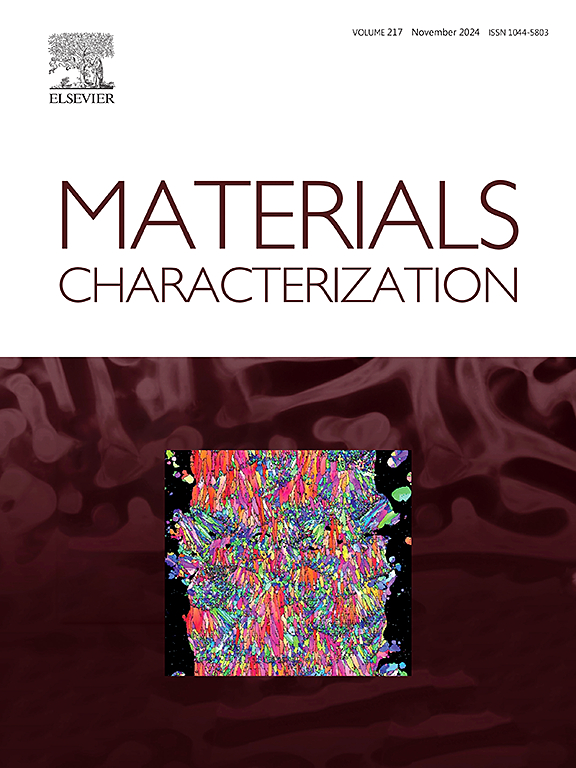Characterizations of the anisotropic features of the phase, texture and deformation behavior of laser powder bed fusion-processed H13 steel
IF 5.5
2区 材料科学
Q1 MATERIALS SCIENCE, CHARACTERIZATION & TESTING
引用次数: 0
Abstract
H13 steel with a relative density of approximately 99.9 % was fabricated by LPBF with 200 °C preheating (H13−200). Samples were built along horizontal (0°, H13![]() 200H) and vertical (90°, H13–200 V) orientations relative to the build platform to investigate the anisotropy of microstructural features and mechanical properties. Despite similar grain morphology, size, and crystallographic texture, the retained austenite (RA) content varied between orientations. H13–200 V exhibited higher RA fractions due to enhanced intrinsic tempering. Compared to previously reported H13 steel processed with similar or no preheating, H13–200 demonstrated higher tensile strength and elongation, with no notable tensile anisotropy observed. The deformation and damage evolution mechanisms were analyzed. Strain hardening and ductility were promoted by the formation of a fine cellular substructure and the transformation-induced plasticity effect from RA. Fractographic and microstructural analyses revealed that RA suppressed crack propagation and contributed to damage tolerance. These results demonstrate that moderate preheating can effectively tailor the phase composition and enhance mechanical performance without introducing notable anisotropy in LPBF H13 steel.
200H) and vertical (90°, H13–200 V) orientations relative to the build platform to investigate the anisotropy of microstructural features and mechanical properties. Despite similar grain morphology, size, and crystallographic texture, the retained austenite (RA) content varied between orientations. H13–200 V exhibited higher RA fractions due to enhanced intrinsic tempering. Compared to previously reported H13 steel processed with similar or no preheating, H13–200 demonstrated higher tensile strength and elongation, with no notable tensile anisotropy observed. The deformation and damage evolution mechanisms were analyzed. Strain hardening and ductility were promoted by the formation of a fine cellular substructure and the transformation-induced plasticity effect from RA. Fractographic and microstructural analyses revealed that RA suppressed crack propagation and contributed to damage tolerance. These results demonstrate that moderate preheating can effectively tailor the phase composition and enhance mechanical performance without introducing notable anisotropy in LPBF H13 steel.
激光粉末床熔合加工H13钢的相、织构和变形行为的各向异性特征
采用LPBF,预热温度为200℃(H13−200),制备出相对密度约为99.9%的H13钢。样品沿水平(0°,H13200H)和垂直(90°,h13 - 200v)方向相对于构建平台构建,研究微观组织特征和力学性能的各向异性。尽管晶粒形态、尺寸和晶体织构相似,但不同取向的残余奥氏体(RA)含量不同。h13 - 200v由于增强了本征回火,表现出更高的RA分数。与先前报道的H13钢相比,H13 - 200在类似或未预热的情况下表现出更高的抗拉强度和伸长率,没有观察到明显的拉伸各向异性。分析了变形和损伤演化机制。微观细胞亚结构的形成和RA的相变诱导塑性效应促进了材料的应变硬化和塑性。断口学和显微组织分析表明,RA抑制裂纹扩展,有助于损伤容限。结果表明,适当的预热可以有效地调整LPBF H13钢的相组成,提高力学性能,而不会引起LPBF H13钢的显著各向异性。
本文章由计算机程序翻译,如有差异,请以英文原文为准。
求助全文
约1分钟内获得全文
求助全文
来源期刊

Materials Characterization
工程技术-材料科学:表征与测试
CiteScore
7.60
自引率
8.50%
发文量
746
审稿时长
36 days
期刊介绍:
Materials Characterization features original articles and state-of-the-art reviews on theoretical and practical aspects of the structure and behaviour of materials.
The Journal focuses on all characterization techniques, including all forms of microscopy (light, electron, acoustic, etc.,) and analysis (especially microanalysis and surface analytical techniques). Developments in both this wide range of techniques and their application to the quantification of the microstructure of materials are essential facets of the Journal.
The Journal provides the Materials Scientist/Engineer with up-to-date information on many types of materials with an underlying theme of explaining the behavior of materials using novel approaches. Materials covered by the journal include:
Metals & Alloys
Ceramics
Nanomaterials
Biomedical materials
Optical materials
Composites
Natural Materials.
 求助内容:
求助内容: 应助结果提醒方式:
应助结果提醒方式:


